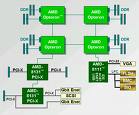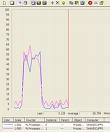
Русский
Укр. Мова
English

|
|
|
|
Multiprocessing is the use of two or morecentral processing units (CPUs) within a single computer system. The term also refers to the ability of a system to support more than one processor and/or the ability to allocate tasks between them. There are many variations on this basic theme, and the definition of multiprocessing can vary with context, mostly as a function of how CPUs are defined (multiple cores on one die, multiple chips in one package, multiple packages in one system unit, etc.). Multiprocessing sometimes refers to the execution of multiple concurrent software processes in a system as opposed to a single process at any one instant. However, the term multiprogramming is more appropriate to describe this concept, which is implemented mostly in software, whereas multiprocessing is more appropriate to describe the use of multiple hardware CPUs. A system can be both multiprocessing and multiprogramming, only one of the two, or neither of the two. Processor symmetry In a multiprocessing system, all CPUs may be equal, or some may be reserved for special purposes. A combination of hardware and operating-system software design considerations determine the symmetry (or lack thereof) in a given system. For example, hardware or software considerations may require that only one CPU respond to all hardware interrupts, whereas all other work in the system may be distributed equally among CPUs; or execution of kernel-mode code may be restricted to only one processor (either a specific processor, or only one processor at a time), whereas user-mode code may be executed in any combination of processors. Multiprocessing systems are often easier to design if such restrictions are imposed, but they tend to be less efficient than systems in which all CPUs are utilized equally. Systems that treat all CPUs equally are called symmetric multiprocessing (SMP) systems. In systems where all CPUs are not equal, system resources may be divided in a number of ways, including asymmetric multiprocessing (ASMP), non-uniform memory access (NUMA) multiprocessing, and clustered multiprocessing. Instruction and data streams In multiprocessing, the processors can be used to execute a single sequence of instructions in multiple contexts (single-instruction, multiple-data or SIMD, often used in vector processing), multiple sequences of instructions in a single context (multiple-instruction, single-data or MISD, used for redundancy in fail-safe systems and sometimes applied to describe pipelined processors or hyperthreading), or multiple sequences of instructions in multiple contexts (multiple-instruction, multiple-data or MIMD). Processor coupling Tightly-coupled multiprocessor systems contain multiple CPUs that are connected at the bus level. These CPUs may have access to a central shared memory (SMP or UMA), or may participate in a memory hierarchy with both local and shared memory (NUMA). The IBM p690 Regatta is an example of a high end SMP system. Intel Xeon processors dominated the multiprocessor market for business PCs and were the only x86 option until the release of AMD's Opteron range of processors in 2004. Both ranges of processors had their own onboard cache but provided access to shared memory; the Xeon processors via a common pipe and the Opteron processors via independent pathways to the system RAM. Loosely-coupled multiprocessor systems (often referred to as clusters) are based on multiple standalone single or dual processor commodity computers interconnected via a high speed communication system (Gigabit Ethernet is common). A Linux Beowulf cluster is an example of a loosely-coupled system. Tightly-coupled systems perform better and are physically smaller than loosely-coupled systems, but have historically required greater initial investments and may depreciate rapidly. Power consumption is also a consideration. Tightly-coupled systems tend to be much more energy efficient than clusters. This is because considerable economies can be realized by designing components to work together from the beginning in tightly-coupled systems, whereas loosely-coupled systems use components that were not necessarily intended specifically for use in such systems. SIMD multiprocessing is well suited to parallel or vector processing, in which a very large set of data can be divided into parts that are individually subjected to identical but independent operations. A single instruction stream directs the operation of multiple processing units to perform the same manipulations simultaneously on potentially large amounts of data. For certain types of computing applications, this type of architecture can produce enormous increases in performance, in terms of the elapsed time required to complete a given task. However, a drawback to this architecture is that a large part of the system falls idle when programs or system tasks are executed that cannot be divided into units that can be processed in parallel. Additionally, programs must be carefully and specially written to take maximium advantage of the architecture, and often special optimizing compilers designed to produce code specifically for this environment must be used. Some compilers in this category provide special constructs or extensions to allow programmers to directly specify operations to be performed in parallel (e.g., DO FOR ALL statements in the version of FORTRAN used on the ILLIAC IV, which was a SIMD multiprocessing supercomputer). SIMD multiprocessing finds wide use in certain domains such as computer simulation, but is of little use in general-purpose desktop and business computing environments. MISD multiprocessing offers mainly the advantage of redundancy,[citation needed] since multiple processing units perform the same tasks on the same data, reducing the chances of incorrect results if one of the units fails. MISD architectures may involve comparisons between processing units to detect failures. Apart from the redundant and fail-safe character of this type of multiprocessing, it has few advantages, and it is very expensive. It does not improve performance. It can be implemented in a way that is transparent to software. MIMD multiprocessing architecture is suitable for a wide variety of tasks in which completely independent and parallel execution of instructions touching different sets of data can be put to productive use. For this reason, and because it is easy to implement, MIMD predominates in multiprocessing. Processing is divided into multiple threads, each with its own hardware processor state, within a single software-defined process or within multiple processes. Insofar as a system has multiple threads awaiting dispatch, this architecture makes good use of hardware resources. Similar conflicts can arise at the hardware level between processors (cache contention, for example), and must usually be resolved in hardware, or with a combination of software and hardware (e.g., cache-clear instructions). |




 Bukhtiiarov Stanislav Alekseevich
Bukhtiiarov Stanislav Alekseevich 











